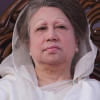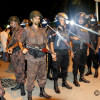Blood, Shock, Horror

The hostage standoff at a Gulshan café ended after around 12 hours but only to bring shockingly grim news for the country and beyond: nine Italians, seven Japanese, two Bangladeshis, one Bangladeshi-American and one Indian are dead.
The 20 hostages were brutally murdered during the chilling siege before the commandoes stormed the popular hangout in Dhaka's diplomatic zone yesterday morning.
Thirteen hostages were rescued while six of the gunmen, who attacked the upscale eatery on Road 79 Friday night, were killed in the 50-minute army-led joint forces operation codenamed "Operation Thunderbolt".
The seventh attacker was held in the operation beginning at 7:40am, officials said.

World leaders were quick to stand in solidarity with Bangladesh yesterday, as the nation reeled from the worst terror attack.
In a televised address to the nation, Prime Minister Sheikh Hasina reiterated her vow to fight militancy and terrorism.
"We will turn Bangladesh into a peaceful state by rooting out terrorists," she said.
The PM declared a two-day national mourning from today.

The hostage crisis, the first-ever such incident in the country, began around 8:30pm after the attackers carrying firearms, bombs and swords barged into the building. It houses Holey Artisan Bakery and O Kitchen restaurant.
Two police officials were killed and dozens others injured on Friday night when law enforcers in groups attempted to close in on.
Global terror outfit Islamic State claimed responsibility for the attack through its Amaq news agency, according to the US-based SITE Intelligence Group.
Dozens of anxious family members waited till morning beyond the police cordon in the diplomatic area -- home to a number of embassies and international schools.
An eerie calm gripped Gulshan as a police blockade in the entire neighbourhood prevented cars from coming in or going out till yesterday noon.
OPERATION THUNDERBOLT
The plan for the operation was finalised at a meeting between the prime minister and chiefs of the three services and top officials of different law enforcement agencies at the Gono Bhaban after 3:00am yesterday, said a source at the Prime Minister's Office.
"We drew a plan at Gono Bhaban about how we would save the hostages from the terrorists," said Hasina at a programme yesterday morning.
The army para commandos were called from Sylhet alongside those from Dhaka and Savar Cantonments, she said.
Around 5:00am, army commandos, navy, police, BGB, Rab and police special force Swat took preparations to begin the operation.
Gunshots and explosions rocked the area as the heavily armed troops backed by armoured vehicles broke into the building at 7:40am.
Nine armoured personnel carriers (APCs) were brought to the scene. Two of those broke through the walls and entered the restaurant premises. An army speedboat was patrolling on the Gulshan Lake adjacent to the restaurant.
Brig Gen Nayeem Ashfaque Chowdhury, director of the Directorate of Military Operations, at a news conference, said, "Led by the para commando of Bangladesh Army, the commando operation began at 7:40am and took 12 or 13 minutes to establish control over the targeted area by eliminating all terrorists."
The operation codenamed "Operation Thunderbolt" was launched after the prime minister ordered the army to intervene to end the hostage crisis, he said.
The operation ended successfully at 8:30pm, he said.
Two Sri Lankans and a Japanese were among the 13 hostages rescued. Six terrorists were killed and a suspected attacker was arrested, Nayeem added.
During a search after the operation, the bodies of 20 people were recovered. They were killed on Friday night, he said, adding, "Most of the victims were killed brutally with sharp weapons."
In his eight-minute press briefing, Nayeem said autopsies of the deceased will be conducted at the Combined Military Hospital (CMH) following existing rituals.
For details and to ascertain identity of the deceased, people have been told to contact army provost martial of Bangladesh Army over a hotline +88-0176-9012524.
A pistol used by terrorists, folded butt AK 22 rifle, an improvised explosive device (IED), a walkie-talkie set and a large number of locally made sharp weapons were recovered from the spot, he said.
Brig Gen Nayeem thanked the PM for her timely, firm and bold decision.
Inter Services Public Relations (ISPR), in a press release issued at 3:20pm, said that all the 20 deceased were foreign nationals.
But another ISPR press release issued at 7:45pm said the nationalities of the 20 victims were yet to be ascertained. The process of identifying them was on, it said.
Though Brig Gen Nayeem said 13 hostages were rescued, a top DB official told The Daily Star that “27 rescued” people have been brought to the DB office on Minto Road.
Most of them were allowed to go home after verifying whether any of them had any links with militancy, the official said around 10:30pm yesterday. The rest were being “released” by turns, he added.
Asked if all the 27 were rescued hostages, he said, “Yes.”
VICTIMS
Nine Italians, seven Japanese, two Bangladeshis, a Bangladeshi American and one Indian are among the dead. They included 11 males and nine females, said ISPR.
Their bodies have been kept at the CMH morgue, it added.
The Italian foreign ministry website said the Italian citizens killed in the Dhaka attack were Adele Puglisi, Marco Tondat, Claudia Maria D'Antona, Nadia Benedetti, Vincenzo D'Allestro, Maria Rivoli, Cristian Rossi, Claudio Cappelli and Simona Monti.
Nadia Benedetti, managing director of Studiotex, a buying house in Dhaka, went to have dinner with five clients from Italy and remained missing since Friday night, said Monohor Corraya, administrative officer of the company.
Japan has confirmed seven of its citizens were among the dead hostages.
Speaking at a press conference in Tokyo late yesterday night, Chief Cabinet Secretary Yoshihide Suga confirmed that seven Japanese -- five men, two women -- were killed in Dhaka siege.
He declined to release their names, saying the government has not yet obtained the consent of the survivors' families.
Around 9:40pm yesterday, Yoshihide Suga said Japanese embassy officials finally identified the seven. They worked for a private company involved in a Jica project.
Japan has also decided to dispatch members of the International Counter-Terrorism Intelligence Collection Unit to Dhaka to strengthen its information gathering efforts.
“Terrorism cannot be justified for any reason. The Japanese Government will work in cooperation with the international community to combat terrorism,” said Japanese Foreign Minister Fumio Kishida at an extraordinary press conference in Tokyo yesterday morning.
“We have decided to dispatch members of the International Counter-Terrorism Intelligence Collection Unit to Dhaka.”
The two dead Bangladeshis are Faraaz Ayaaz Hossain, 20, an undergraduate student at Emory University in Georgia of the US, and Ishrat Akhond, human resources director at ZXY International FZCO and Arts Provocateur at Institute of Asian Creatives, Dhaka.
The US-Bangladeshi victim was Abinta Kabir, a student of Oxford College of Emory University.
Abinta, from Miami in the state of Florida, was in Bangladesh to visit family and friends, said university president James Wagner in statement, reports AFP.
The Indian citizen, Tarishi Jain, 18, a student of the University of California, Berkeley, the US, came to Dhaka on vacation, said sources in the Indian foreign ministry.
Meanwhile, three of those injured in assaults by the gunmen were in critical condition till yesterday evening, hospital officials said.
Police officer Sujan Kumar, who was hit with splinters in the head, face and legs, and restaurant waiter Zakiur who suffered bullet wounds below the chest, were being treated at the ICU at the United Hospital.
“They suffered a lot of blood loss,” Shagufa Anwar, chief of communications and business development of the United Hospital, told The Daily Star yesterday.
The third, a driver named Razzak, was at Dhaka Medical College Hospital.
Twenty-three injured policemen were admitted to United Hospital and two others to the DMCH.
ATTACKERS
Inspector General of Police AKM Shahidul Hoque said all the attackers were Bangladeshi citizens.
Of the six, five were certainly militants and they had been trying to arrest them, he told reporters at Rajarbagh Police Lines after attending the namaz-e-janaza of the two dead police officials.
"We had searched for them in different places of the country and now they were killed here," the IGP added.
The police headquarters last night released the names of five gunmen with photographs of their corpses. They are Akash, Bikash, Don, Badhon, and Ripon.
Police, however, did not give details of the attackers or their motive.
Officials only said the gunmen used nicknames during their mission and Ripon was their kingpin.
NO 'PROPER PREPARATION'
The attack came amid a series of targeted killings carried out by suspected militants across the country.
Over the last two years or so, suspected militants have attacked and killed university professors, writers, publishers, secular bloggers, gay rights activists, foreigners, policemen and members of religious minorities, including Shia and Sufi Muslims, Christians and Hindus.
The Islamic State reportedly claimed responsibility for a number of such killings. The government carried out a weeklong anti-militancy clampdown from mid-June, arresting around 13,000 people including 194 suspected militants.
Like previous targeted killing, the murders in Gulshan were brutal in nature as the victims were mostly slaughtered with sharp weapons.
Security analyst Brig Gen (Retd) M Sakhawat Hossain said the intelligence agencies were “over burdened” with different other tasks but they were hardly aware that something big was going to happen.
"... We couldn't take proper preparation. We couldn't direct the forces properly," he told The Daily Star.

 For all latest news, follow The Daily Star's Google News channel.
For all latest news, follow The Daily Star's Google News channel. 


















Comments